Lorries cross a bridge shrouded in haze in Klang, Malaysia, on Wednesday. The thick so-called “haze,” caused by slash-and-burn clearances on the islands of Sumatra and Borneo, has pushed air quality to unhealthy levels in Malaysia and neighboring Singapore: photo by Olivia Harris/Reuters, 7 October 2015
At once as far as Angels kenn he
views
The dismal Situation waste and wilde,
A Dungeon horrible, on all sides round
As one great Furnace flam'd, yet from those flames
No light, but rather darkness visible
Serv'd onely to discover sights of woe,
Regions of sorrow, doleful shades, where peace
And rest can never dwell, hope never comes
That comes to all; but torture without end
Still urges, and a fiery Deluge, fed
The dismal Situation waste and wilde,
A Dungeon horrible, on all sides round
As one great Furnace flam'd, yet from those flames
No light, but rather darkness visible
Serv'd onely to discover sights of woe,
Regions of sorrow, doleful shades, where peace
And rest can never dwell, hope never comes
That comes to all; but torture without end
Still urges, and a fiery Deluge, fed
With
ever-burning Sulphur unconsum'd
John Milton: Paradise Lost, Book I
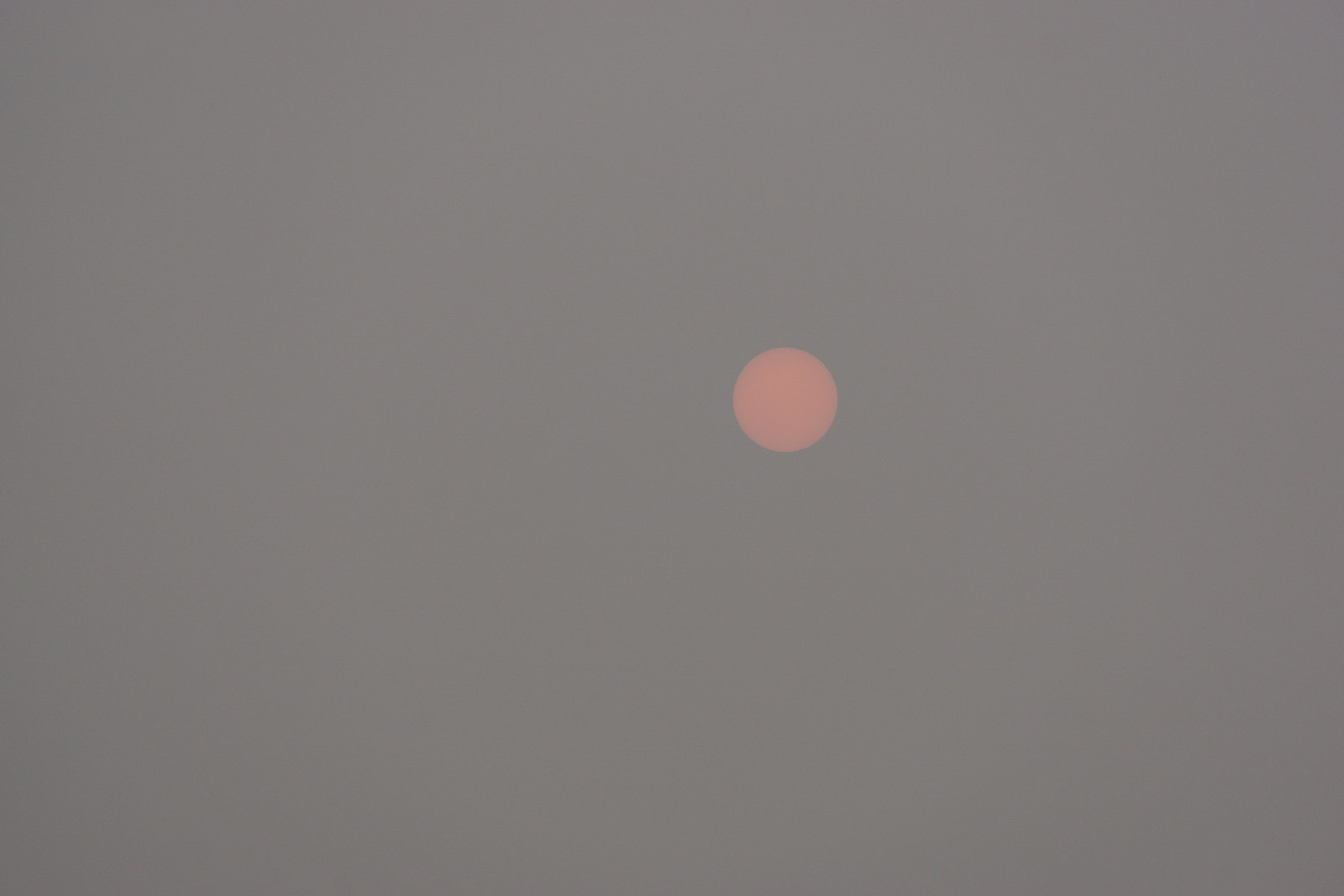
Sun in Haze (Singapore): photo by aamanatullah, 24 September 2015
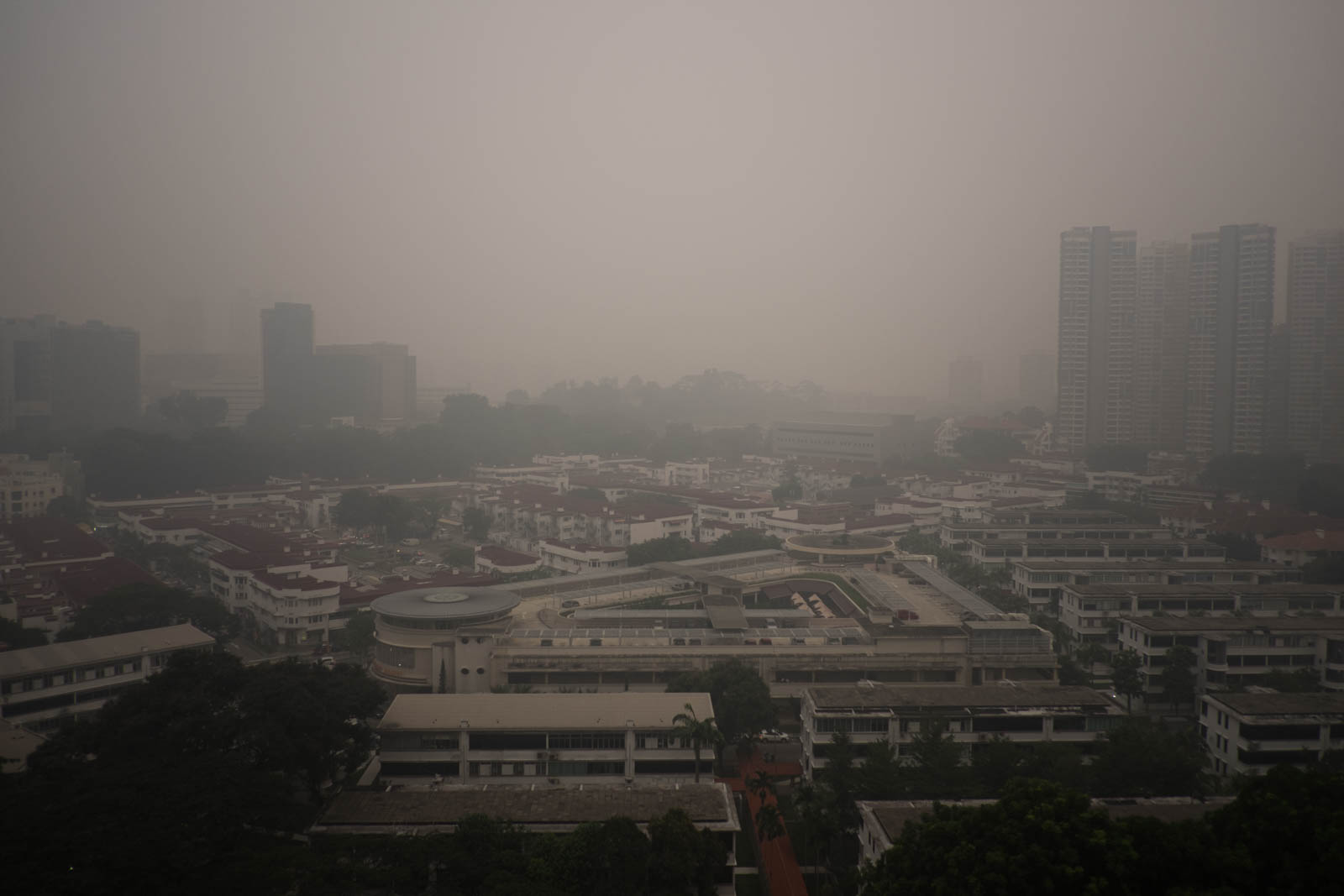
PS! 253 over Tiong Bahru, Central Singapore. You could see, smell and taste the haze tonight in Tiong Bahru area. The air is no more fresh and you deeply breathe smoke if you don't wear a proper mask (#N95 at least). Condition worsens a lot today. Massive deforestation (mostly in Sumatra and Borneo) to increase palm oil production is ongoing. To speed up the process, people burning a forest. The heavy and dense smoke is then spreading all over the region from Kuala Lumpur to Palembang: photo Charles Collier, 24 September 2015
Caught in the fires

A male orangutan (Pongo pygmaeus) in Tanjung Puting National park, Central Kalimantang, Indonesia: photo by CIFOR, 13 August 2010
Widespread forest fires, many set deliberately to clear land for oil
palm plantations, have been disastrous for Sumatran orangutans.
Thousands are thought to have burned to death, unable to escape the
flames both in Sumatra and Kalimantan.
The
species' range is now severely circumscribed, says WWF in Jakarta. Of
nine populations left in Sumatra, only seven are thought viable. "The
fate of Sumatran orangutans is inextricably linked to the island's
fast-disappearing forests. If we want to save the Sumatran orangutan we
have to save their forest home," said Barney Long, WWF's Asian species
expert.
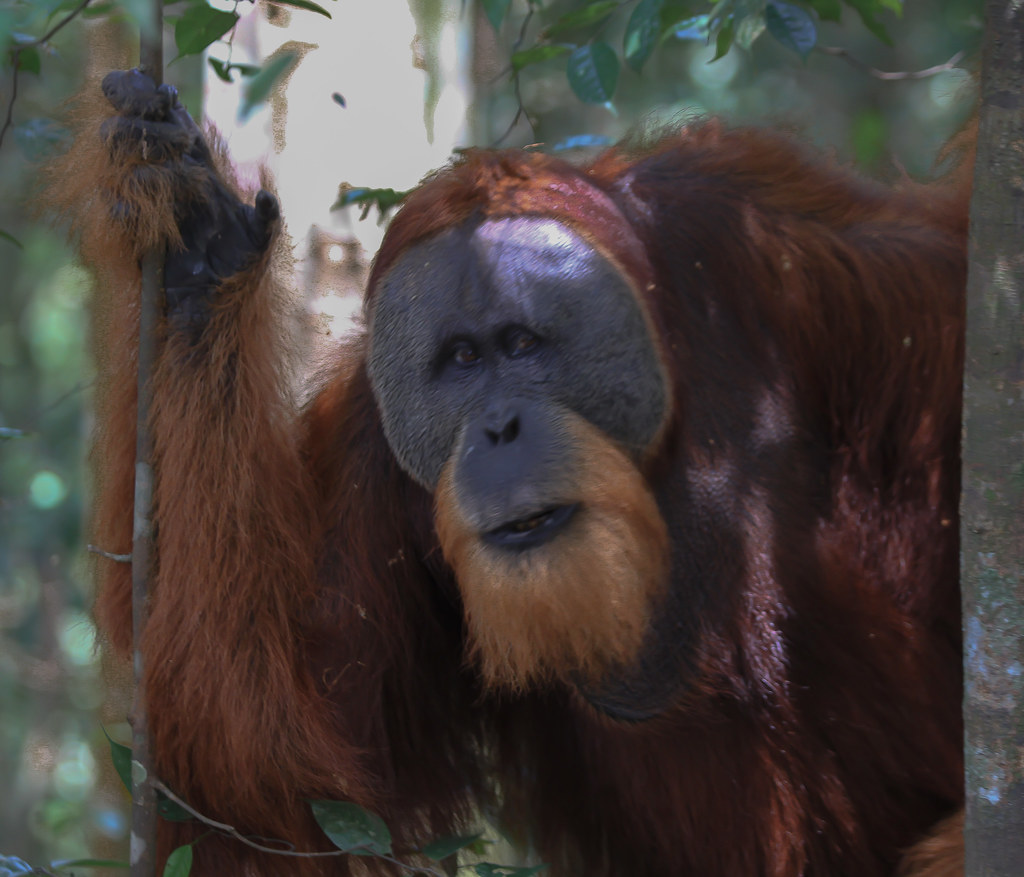
Orangutan, Sumatra, Indonesia: photo by Carol Mitchell, 12 July 2014

Smoke rises as a fire burns in a forest in Ogan Komering Ilir Regency, a regency of South Sumatra province, Indonesia: photo by Nova Wahyudi/Antara Foto/Reuters, 20 October 2015

Smoke rises as a fire burns in a forest in Ogan Komering Ilir Regency, a regency of South Sumatra province, Indonesia: photo by Nova Wahyudi/Antara Foto/Reuters, 20 October 2015
Orangutans in the haze shrouding the Borneo Orangutan Survival Foundation camp: photo by Antara Foto/Reuters, 5 October 2015: image via John R Platt @johnrplatt, 22 October 2015 PORTLAND, OR
Orangutans Are Dying as Indonesia Burns: Thousands of forest fires set by palm
oil companies across Sumatra and Borneo threaten not just endangered
apes but the global climate: John R. Platt, TakePart, 22 October 2015
Indonesia is on fire.
Right now, tens of thousands of small forest fires are burning
across the islands of Sumatra and Borneo, the only habitats for
orangutans and other rare species. Many of the fires appear to have been
intentionally set by palm oil companies, which employ slash-and-burn agriculture to clear land of native trees
to plant their cash crop, which is used as an ingredient in everything
from food to cosmetics.
Richard Zimmerman, executive director of Orangutan Outreach,
calls the conflagrations a disaster for endangered orangutans. Some of
the fires are burning in important orangutan habitats, including
Borneo’s Sabangau National Park, thought to hold the largest wild
population of orangutans. “This is catastrophic,” Zimmerman said. He
said he’s worried about how many wild orangutans have died from the
flames and resulting smoke.
“The
problem with fire and smoke is absolutely dire,” said Lis Key,
communications manager for International Animal Rescue, which runs a
rehabilitation center for more than 125 injured and orphaned orangutans
in Ketapang, Borneo.
“Wild orangutans and orangutans in centers like ours are badly
affected by the smoke,” she said. “Some suffer upper respiratory tract
infections, which can even prove fatal. Some of the babies we’ve taken
in recently have been suffering not only from dehydration and
malnourishment through lack of food but also breathing problems from the
polluted air.”
No matter where the fires are, they have raged out of control owing
to an abnormally dry and windy season caused by El Niño weather
patterns. Zimmerman said the situation is similar to that in
drought-plagued California, where forest fires have grown in frequency
and intensity over the past few years.
Indonesia’s fires are much worse than California’s, however. Not only
are they deliberately set, but many of them occur in carbon-rich peat
forests. These forests -- which would normally be wet and hard to burn at
this time of year -- grow out of several meters’ worth of damp, rich
organic matter instead of soil. Zimmerman said the peat forests are so
dry this year that “one match or a cigarette would let it all go up in
flames.”
Not only does this release more carbon than normal forest fires, but
it makes fires harder to control. “Even if things look fine, there are
actually fires burning 20 feet below the ground,” Zimmerman said. “You
have these teams of people doing their best to extinguish small fires or
hot spots, but the fire can come back up 100 meters behind them. It’s a
constant vigil.”
Orangutans have more to fear than just the fire. The flames and smoke
are pushing them out of their already reduced habitats and closer to
human villages, where the adults are killed and the young apes are sold
into the pet trade. In the past week, International Animal Rescue saved
one such young orangutan, Gito, who had been kept in a cardboard box and left in the sun to die.
Two more young orangutans were repatriated to Indonesia this week after they were rescued from smuggers
at the airport in Kuala Lumpur, Malaysia. A report last year from the
Great Apes Survival Partnership found that many illegally obtained
orangutans are being sold to China for display in zoos and other entertainment facilities.
Although most adult orangutans that escape the fires are killed by
poachers, a few are luckier. Key reported that her group recently
relocated 10 wild orangutans that had been found “stranded close to palm
oil concessions or in areas of forest that have been destroyed by
fire.”
The
fires threaten more than just Indonesia’s wildlife: They have also
created a cloud of smoke and haze big enough to be seen from space and
are releasing an estimated 15 to 20 million tons of carbon dioxide per
day -- more than he emissions from the entire U.S. economy. “This isn’t
just one little fire in one little area,” Zimmerman said. “It’s the
whole earth.”
And
there’s no end in sight. Malaysia’s environment minister this week
warned that the Indonesian fires are so bad that human efforts can't
control them until the rainy season begins in mid-November, if then.
Still, Zimmerman said his group is collecting funds
to help support villagers, firefighters, and local conservation
organizations. After that, it will start surveys to see how many
orangutans have been lost. “When these fires finally end, that’s when
we’ll see the bodies,” he said.
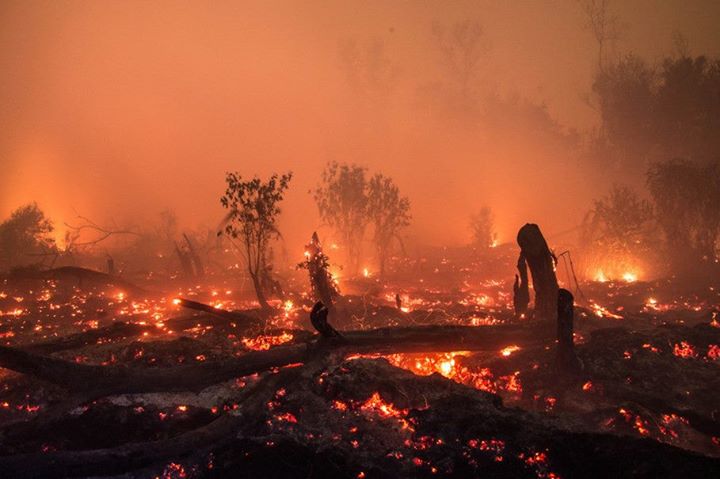
#Indonesia Worst threat in century to people, orangutans, wildlife & Western media's not even mentioning it! #palmoil: image via PeSSouZiX @PeSSouZiX, 23 October 2015
Haze
Students walk along a street as they are released from school to return home earlier due to the haze in Jambi, Indonesia’s Jambi province, Tuesday. Indonesia has sent nearly 21,000 personnel to fight forest fires raging in its northern islands: photo by Antara Foto/Wahdi Setiawan/Reuters, 29 September 2015
#Indonesia readies warships for haze evacuations, says gov't minister. #VOAlert: image via Steve Herman Verified Account @W7VOA, 23 October 2015

Forest fires have been burning out of control across Indonesia for months, blanketing Palangkaraya in Central Kalimantan province and other parts of South-East Asia in smog: photo by Hugo Hudoyoko/European Pressphoto Agency, 23 October 2015
Muslim students pray for rain to put out the fires which enveloped the region at Palembang 1 senior high school in Palembang, South Sumatra, Indonesia, on Thursday: photo by Feny Selly/Antara Foto/Reuters, 17 September 2015
The dismal Situation waste and wilde
Indonesia moves to stop forest fire pollution as haze grips Singapore #smog #cleanair: image via CECHR @CECHR, 16 September 2014
#Indonesia's Fire Crises: the biggest environmental crime of the 21st century [Jakarta Globe... by @emeijaard]: image via Alessio Fratticcioli @fratticcioli, 24 October 2015
Indonesia readies warships for haze evacuation: image via Agence France-Presse @AFP, 24 October 2015
Indonesia readies warships for haze evacuation: AFP, 24 October 2015
Jakarta (AFP) - Indonesia has put
warships on standby to evacuate people affected by acrid haze from
forest fires which has killed at least 10 and caused respiratory
illnesses in half a million, officials said Saturday.
For
nearly two months, thousands of fires caused by slash-and-burn farming
in Indonesia have choked vast expanses of Southeast Asia, forcing
schools to close and scores of flights and some international events to
be cancelled.
The government has decided to send
ships to haze-affected provinces to evacuate victims, especially
children and women, if necessary, with two warships deployed to
Kalimantan on Friday and another carrying medical workers and health
equipment expected Saturday.
Military spokesman
Tatang Sulaiman said the warships, which will be standing by in
Banjarmasin, the capital of south Kalimantan, could serve as evacuation
centers and hospitals for those affected by the haze.
Tatang
said there was no immediate plan to bring people onboard but that could
change if hospitals on land reach capacity or become overwhelmed.
"The
ships are sent just in case children or pregnant women must be
relocated from the local health facilities, it does not mean everyone
would be put into the ships," Tatang said.
"So far
health facilities on the ground in Kalimantan are still trying their
best, we are just getting ready by deploying warships," Tatang said.
Each warship can carry up to 2000 people and has 344 beds onboard.
"For
now the ships will be standing by. We will begin evacuation when there
is an instruction from the government," navy spokesman Muhammad
Zainuddin told AFP.
'Extraordinary crime'
The
government has deployed around 30 aircraft to fight the fires and for
cloud seeding with 22,000 troops on the ground to combat the blazes.
Indonesian
disaster mitigation agency spokesman Sutopo Purwo Nugroho said the
fires had killed 10 people so far, some fighting the blazes while others
died of respiratory illnesses or medical conditions exacerbated by the
pollution.
"The impact of the forest fires has caused 10 people in Sumatra and Kalimantan to die, directly and indirectly," Nugroho said.
The figure did not include seven hikers killed in a wildfire on Java last week.
The
agency estimated at least half a million people have suffered from
respiratory illness since the fires started in July and 43 million
people have been affected in the islands of Sumatra and Kalimantan.
Nugroho
said the figure was likely just the tip of the iceberg because many
people did not go to health facilities for treatment.
More
than 1.7 million hectares (4.2 million acres) of land has been burned
and six provinces severely affected by the haze, according to
Indonesia's forestry ministry.
"This is due to human
acts because 99 percent of forest fires were started deliberately. This
is an extraordinary crime against humanity," Nugroho said.
Other
countries such as Malaysia, Singapore, Australia and Japan have sent
assistance to help Indonesia fighting the forest fires.
With
Malaysia, Singapore and parts of Thailand already affected, the
Philippines Friday said the haze had now spread there, disrupting air
traffic and prompting warnings for residents to wear face masks.
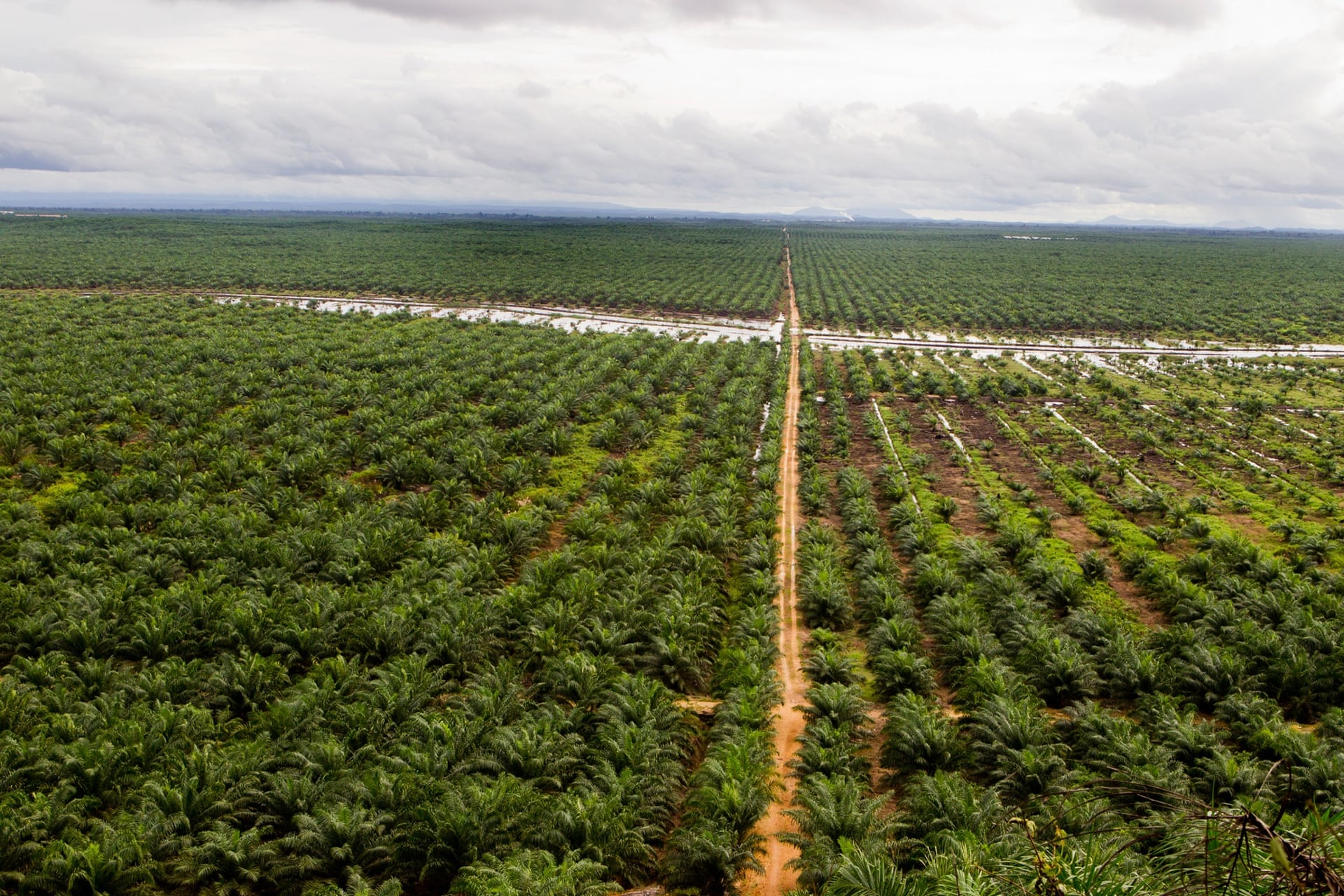
Palm oil plantations, such as this one covering thousands of hectares, are causing habitat-loss for many Indonesian species, although pangolins are one of a few that have limited tolerance to palm-oil habitats. The average monthly wage for an Indonesian working full-time on a plantation is $47 and many turn to poaching because they can earn 10 times as much: photo by Paul Hilton for WildAid via the Guardian 10 March 2015
Indonesia's Wildfires Are as Bad as Some of the Planet's Worst Air Polluters: An eye-popping amount of greenhouse gas issues from the thousands of blazes in the Southeast Asian country: Liz Dwyer, TakePart, 22 October 2015
They’ve
burned for weeks, producing toxic smoke that has blanketed much of
Southeast Asia and caused air quality to plummet. But just how bad is
the pollution generated by the wildfires raging across Indonesia?
Between
Sept. 1 and Oct. 14, the fires -- which are allegedly being
intentionally set by businesses looking to make a buck producing palm
oil -- may have produced more air pollution than Germany does in a
calendar year.
Although Germany has one of the worst pollution problems in Europe, try this on for size: The pollution generated
from the fires is also greater than the single-day emissions of the
second-largest producer of greenhouse gases on the planet, the United
States.
That’s the startling finding
of a team of researchers led by Guido van der Werf, a scientist at VU
University Amsterdam in the Netherlands. Van der Werf and his team
estimated the amount of air pollution being produced by the fires using
data from previous blazes in Indonesia.
They calculated that the more than 100,000 blazes that have
burned Indonesia’s carbon-rich peatlands this year generated more than
1,102 million metric tons of carbon dioxide. To put that into
perspective, in 2013, the entire United States generated 6,673 million
metric tons, according to the EPA.
Thanks
to the suffocating haze created by these fires, schools across
Indonesia -- and its neighboring nations, Malaysia and Singapore -- are
closing intermittently when pollution levels spike. Battling the blazes
has been exceptionally
difficult for firefighters this year because the island nation is a
tinderbox. While El Niño creates wetter conditions on the West Coast of
the United States, it leads to drought in Southeast Asia.
Indeed,
the arrival of the monsoon in the region has been significantly delayed
by El Niño, and Indonesia has been hard hit by the lack of rain.
Farmers have suffered extreme crop losses, and in the ultimate
irony, given the role the industry allegedly plays in setting the fires,
palm oil production is expected to drop.
Van der Werf’s team found that more than 4,700 fires were burning in Indonesia on Oct. 14 alone. It seems an improvement in air quality shouldn't be expected anytime soon.
"Unless
there is rain, there is no way human intervention can put out the
fires," Wan Junaidi Tuanku Jaafar, the natural resources and environment
minister in neighboring Malaysia, warned on Monday, the Australian Broadcasting Corporation reported.
Students walk along a street as they are released from school to
return home earlier due to the haze in Jambi, Indonesia’s Jambi
province, Tuesday. Indonesia has sent nearly 21,000 personnel to fight
forest fires raging in its northern islands: photo by Antara Foto/Wahdi Setiawan/Reuters, 29 September 2015

Sun in Haze (Singapore): photo by aamanatullah, 24 September 2015

Sun in Haze (Singapore): photo by aamanatullah, 24 September 2015

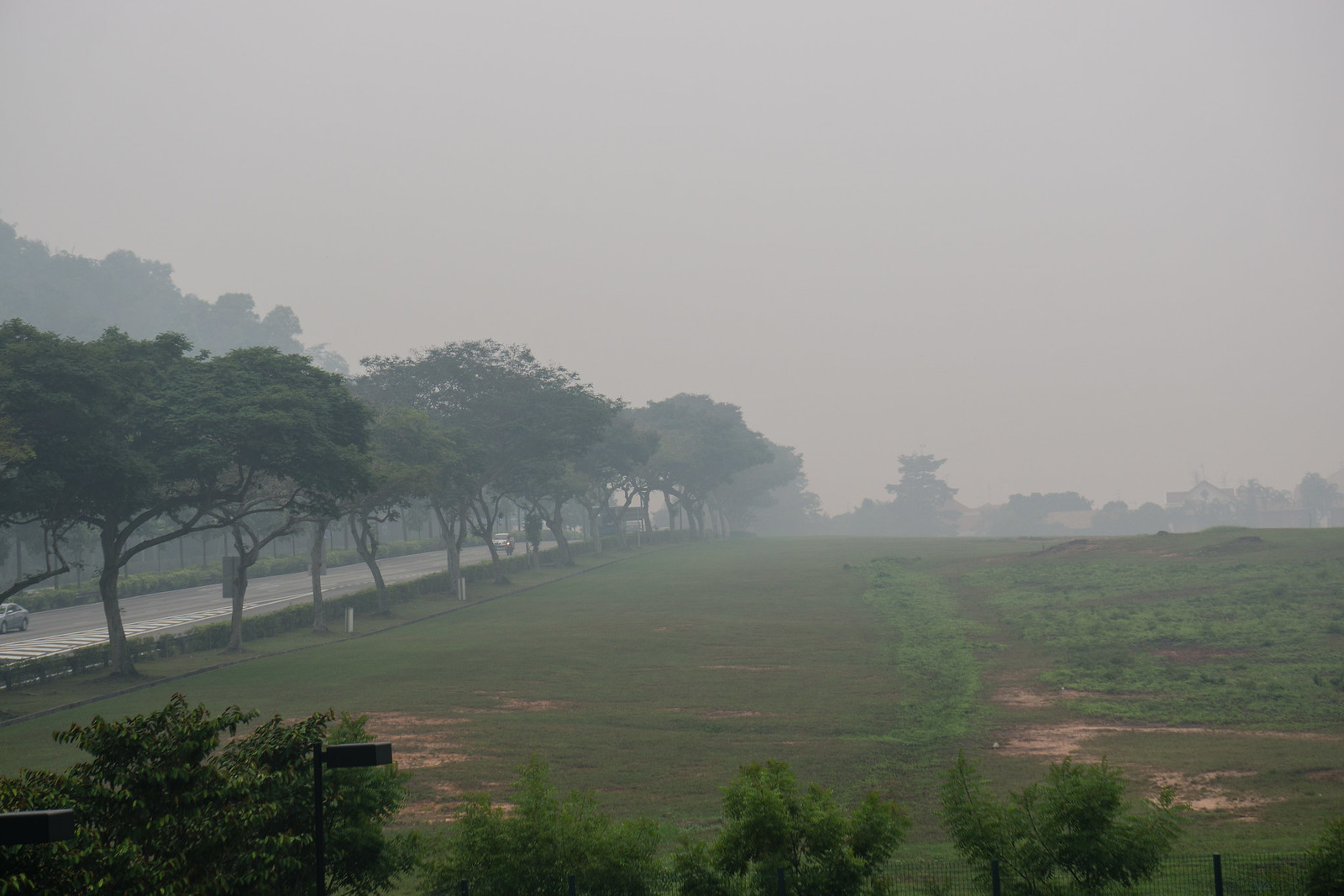
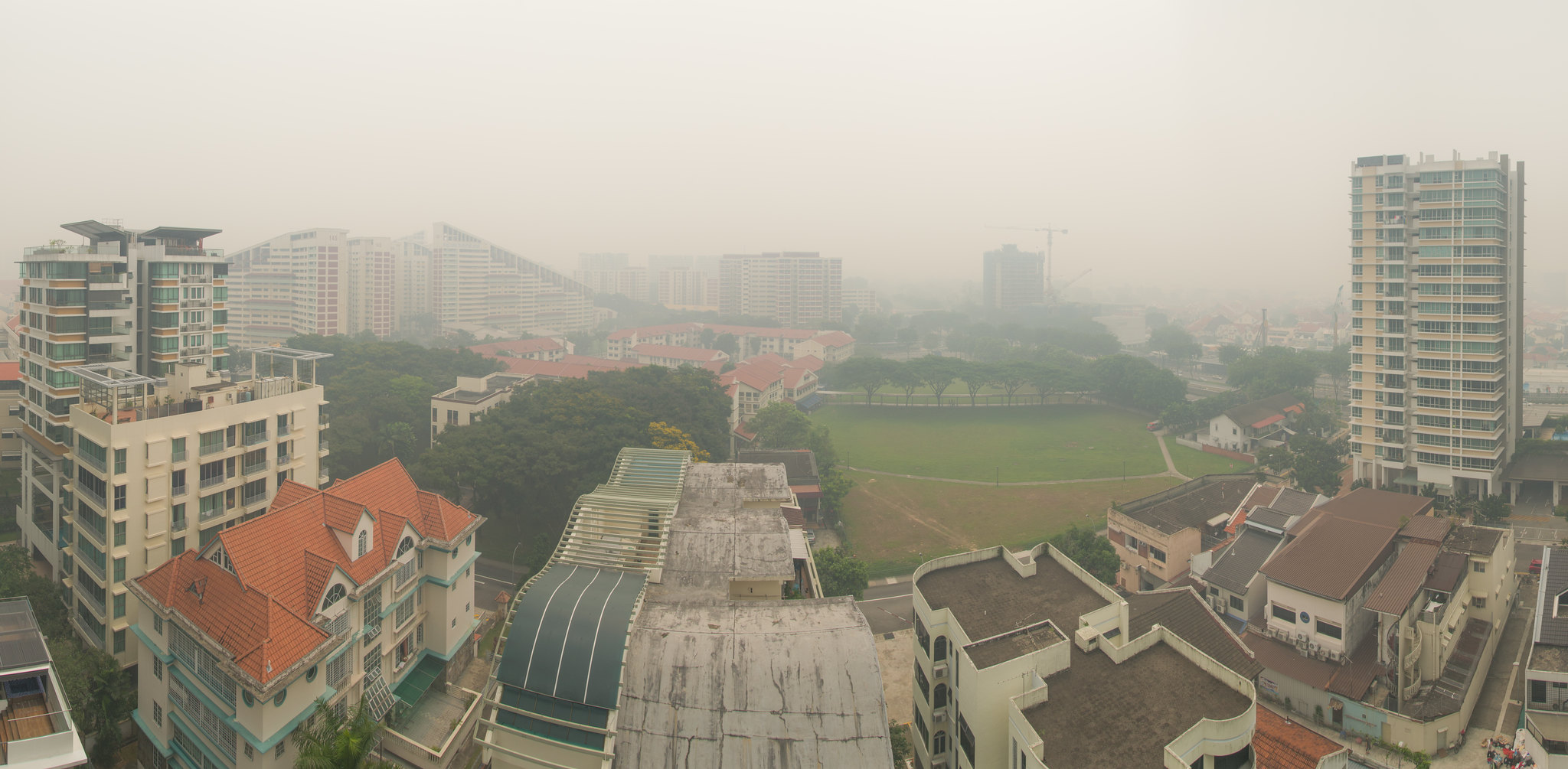
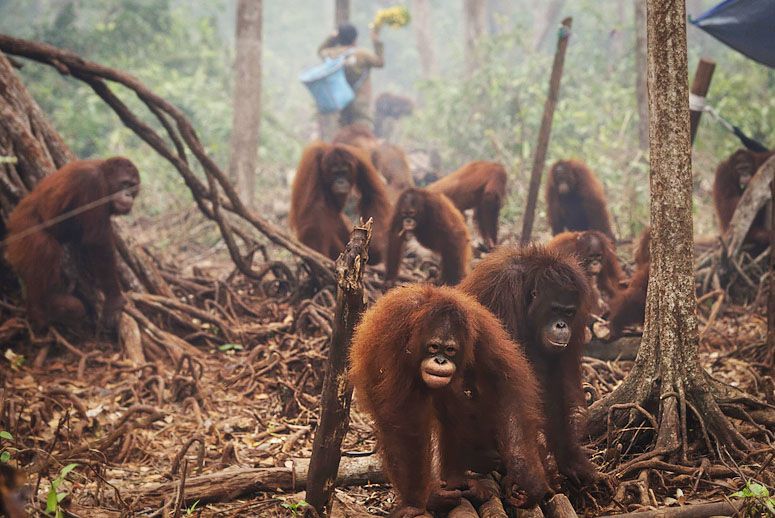


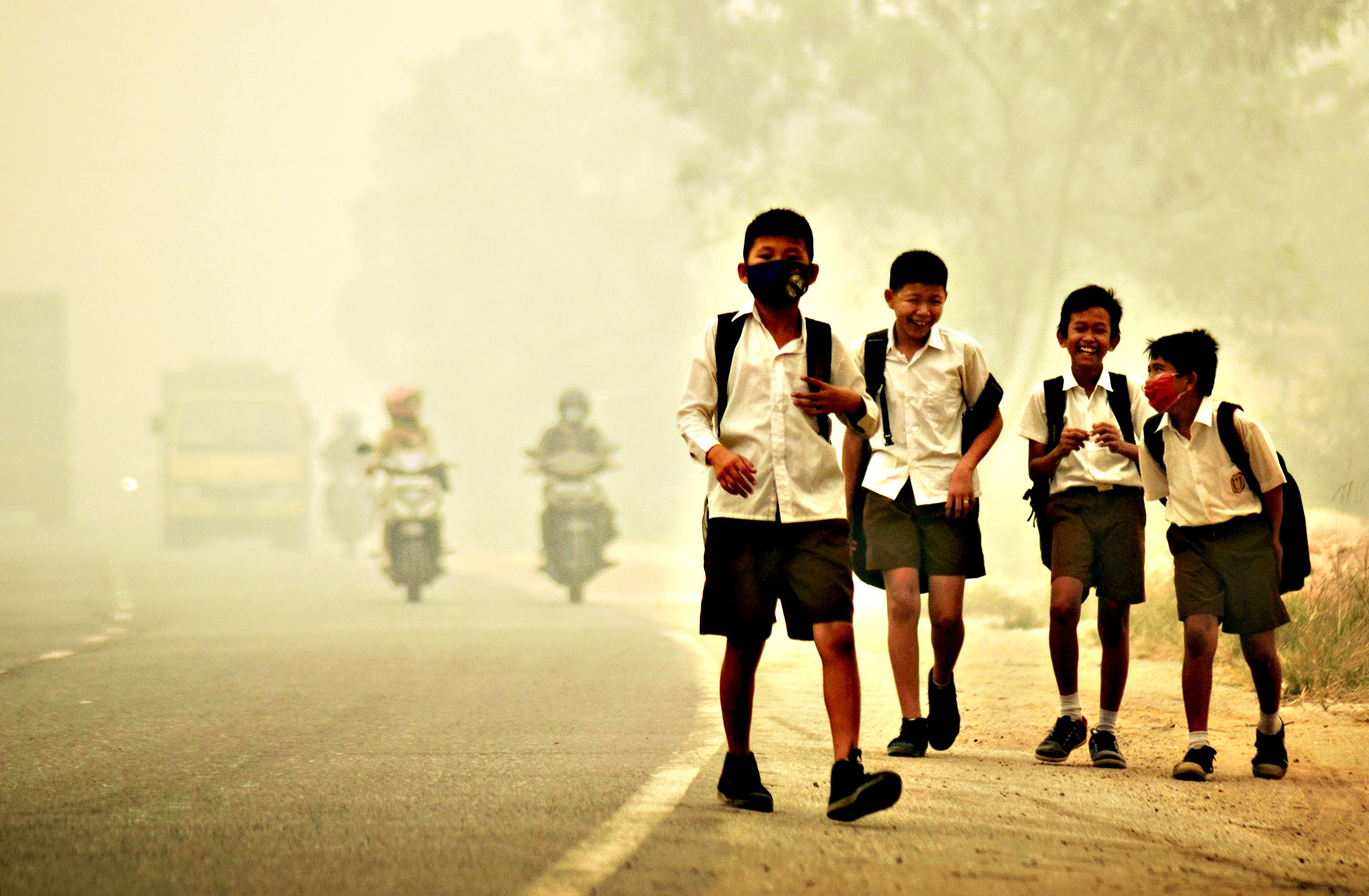
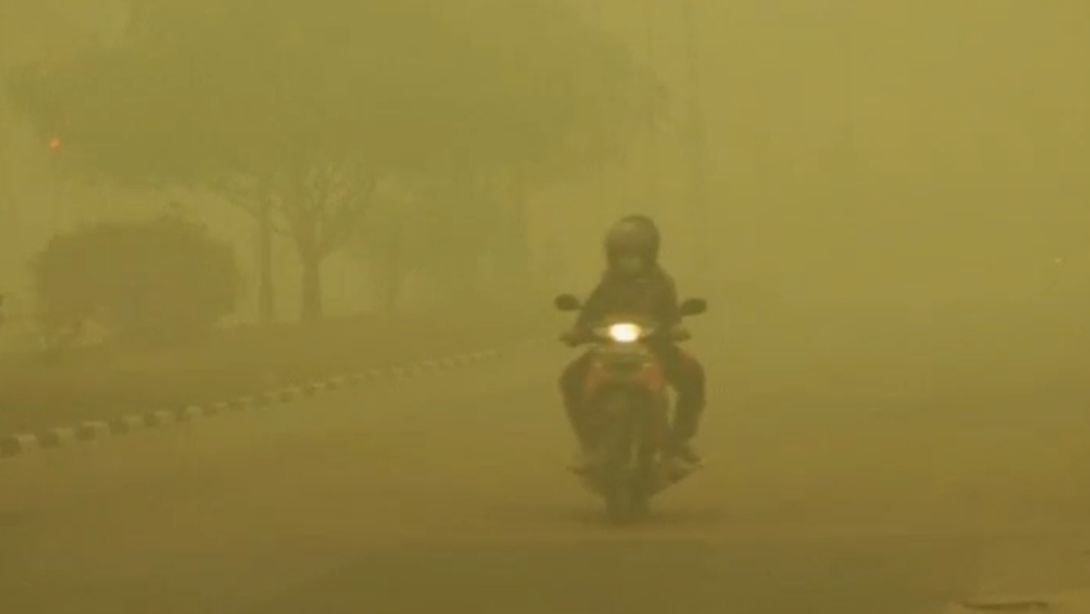
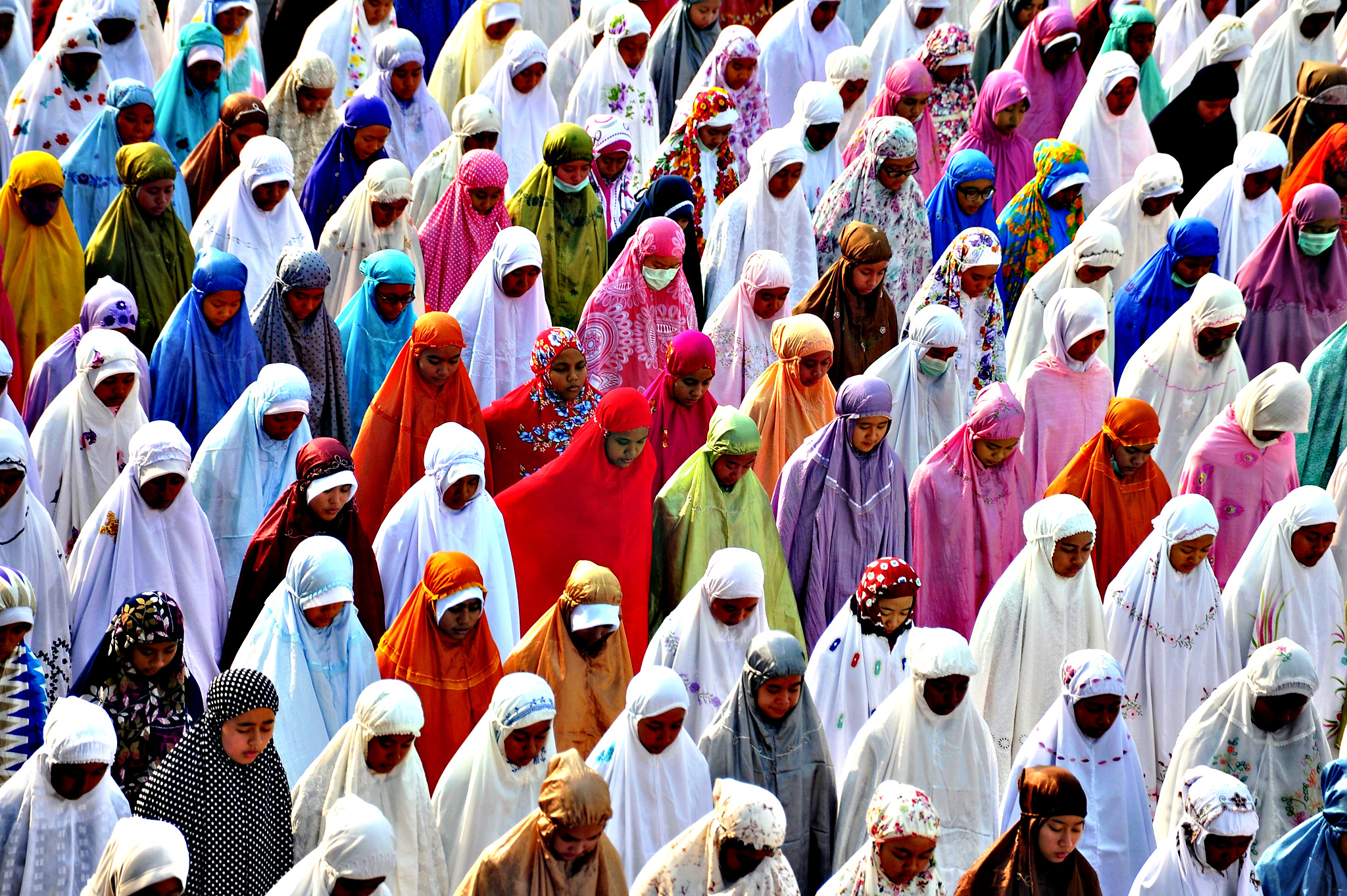

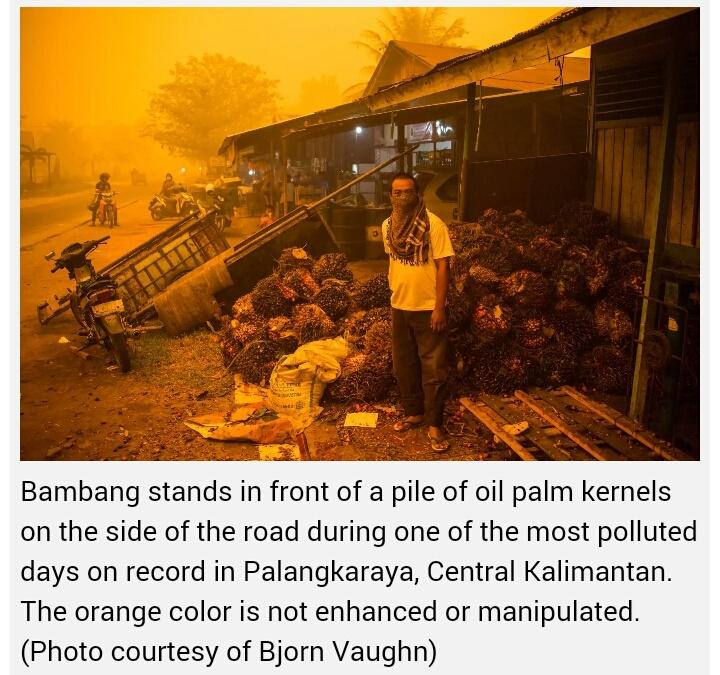
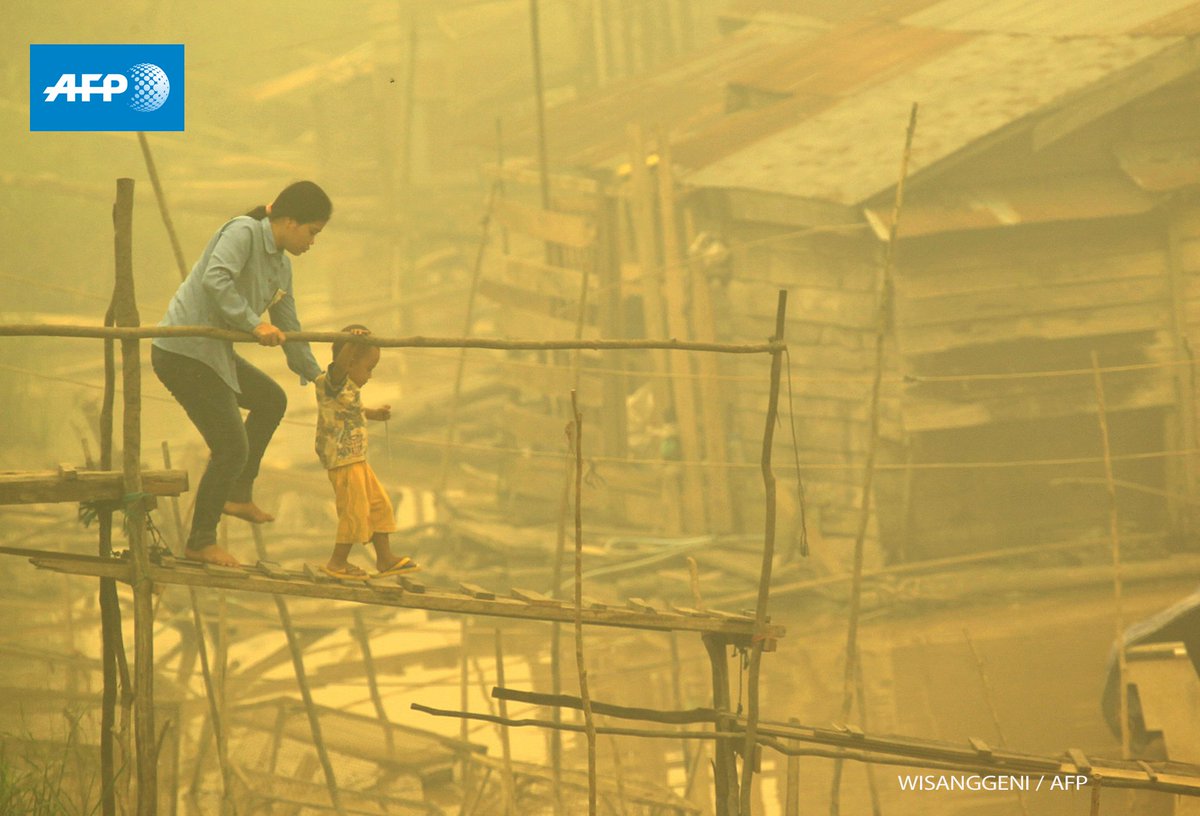




5 comments:
After Hours (1995) feat. Peggy Lee: Is that all there is?
Peggy Lee: Is that all there is? (Leiber & Stoller), live, 1969
Dismal, indeed. And heart-breaking.
"Watch the whole world go up in flames".
That's about it, that darkness visible; our own end staring us in the face.
Many thanks, Terry and Duncan, fellow breathers in a suffocating world.
Looking at pictures and videos from Indonesia in working up this post it was at times necessary to remind oneself these were not images from a bad hollywood disaster movie.
How Serious Is the Haze Problem in Indonesia...?
And here I'd thought the air in the 880 corridor was bad.
Singapore has been having Pollutants Standards Index, or PSI, readings over 300... Just recently they scored a cool 341... but of course that's as nothing next to the numbers from the source, Indonesia, where they're getting readings up to 2000 PSI (the point where the recording instruments choke to death).
As anybody in Singapore or Kuala Lumpur can testify, even distance from wholesale environmental desecration is not protection from the devastation.
Watching the Mexican hurricane on live streams here was a[nother] grim and redundant instruction in the rapidly arriving future of a crumbling civilization. Many a gringo resort vacation package to Puerto Vallarta aborted, many a group bargain flight cancelled.
The flood of traffic out front never ebbed all the while, for all the world as though there were no perceived connection between carbon emission and the biophysical future of Earth.
This from the Center for International Forestry Research, on Wednesday last:
"The fires raging across Indonesia, and the hazardous smoke they create, are causing even greater damage to the environment, wildlife and communities than first imagined. While much of the recent focus has been on Sumatra—and the spillover into Singapore and Malaysia—the province of Central Kalimantan, on the island of Borneo, faces a greater crisis.
"Once called the 'lungs of the world', the rainforests and peatlands of Borneo are struggling to breathe, as they spew vast quantities of smoke into the air, amid some of the worst fires in almost 20 years. Despite major efforts to douse the flames, in this dry El Niño year, there is no telling when the fires will subside and the air will clear."
And this from an interested scientific observer at the scene in Kalimantan, Martin Wooster, Professor of Earth Observation Science at King’s College London:
“There is a complete envelopment of smoke all over the place.
“And if you’re here without a mask, you are breathing much of that smoke into your lungs, which is obviously, I would say, extremely hazardous for your health.
“I’ve visited quite a few sites of biomass burning during my 10 years or so of research in the area. And I can certainly say this is the worst situation I’ve ever encountered for biomass burning or any form of combustion in a natural environment.
“Here you’ve got the actual soils that are burning alongside the vegetation on top, which is often seen in ferns and things that are quite flammable, not the original forest.”
Over-population.
Environmental degradation.
No one in the public media talks about these things.
They get worse and worse.
Oh, let's build the tunnels and suck the Sacramento River dry. And while we're at it, drain the Central Valley Aquifer too. Good show.
Let's build a bullet-train to LA. Good show.
Let's build more high rise condos in SF. Good show.
So, how about prayer? That's the trick. Or hand-wringing.
Consciousness of death.
Witness.
Post a Comment